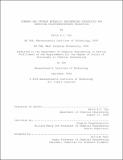Forward and inverse metabolic engineering strategies for improving polyhydroxybyrate production
Author(s)
Tyo, Keith E. J
DownloadFull printable version (3.289Mb)
Other Contributors
Massachusetts Institute of Technology. Dept. of Chemical Engineering.
Advisor
Gregory Stephanopoulos.
Terms of use
Metadata
Show full item recordAbstract
Forward metabolic engineering (FME) is a rational approach to cellular engineering, relying on an understanding of the entire metabolic network to direct perturbations for phenotype improvement. Conversely, inverse metabolic engineering (IME) uses a global, combinatorial approach to identify genetic loci that are important for a given phenotype. These two approaches complement each other in a strain improvement program. FME and IME approaches were applied to poly-3-hydroxybutyrate (PHB)production in Synechocystis PCC6803 [IME] and recombinant E. coli [FME] in this thesis.IME was appropriate for Synechocystis, where metabolic regulation of the native PHB pathway was not well understood. A high throughput screening method was established by developing a staining protocol that quantitatively related nile red fluorescence to PHB content, while maintaining cell viability for both organisms. This was combined with fluorescence activated cell sorting (FACS) to screen for high PHB mutants. A Synechocystis insertion mutagenesis library was screened to identify gene disruptions that increased PHB. Two gene disruptions in proline biosynthesis and an unknown function were identified and characterized.An analogous IME study in E. coli did not find increased PHB mutants, but suggested an FME approach on the PHB pathway. Systematic overexpression of the pathway revealed phaB, acetoacetyl-CoA reductase, limited PHB flux. Beyond this, whole operon overexpression led to even higher PHB fluxes.In a nitrogen-limited chemostat, PHB flux did not change with dilution rate. Unlike prior pleiotropic perturbations, these systematic experiments could clearly conclude that the flux control is in the PHB pathway. At high PHB flux, growth rate was extremely hindered and was accompanied by PHB plasmid genetic instability and rapid PHB productivity loss. (cont.) Tandem gene duplication (TGD) was developed to slow productivity loss caused by "allele segregation," a fast process that propagates a DNA mutation to all copies of a plasmid. By placing the many copies in tandem, rather than on individual plasmids, allele segregation could be avoided, increasing stability significantly.These methods and results should support PHB engineering in higher photosynthetic organisms and better E. coli PHB production in batch or continuous culture.TGD is a broadly applicable technique for high level recombinant expression.
Description
Thesis (Ph. D.)--Massachusetts Institute of Technology, Dept. of Chemical Engineering, 2008. Includes bibliographical references (p. 165-174).
Date issued
2008Department
Massachusetts Institute of Technology. Department of Chemical EngineeringPublisher
Massachusetts Institute of Technology
Keywords
Chemical Engineering.